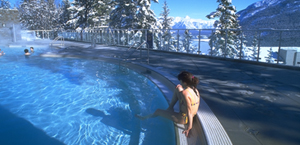The water
The top five minerals found in the Banff Upper Hot Springs are:
- Sulphate- 572 mg/l
- Calcium- 205 mg/l
- Bicarbonate- 134 mg/l
- Magnesium- 42 mg/l
- Sodium- 6.6 mg/l
The water temperature is kept between 37ºC and 40ºC or 98ºF and 104ºF.
The flow of natural spring water in the Banff Upper Hot Springs is currently insufficient to fill the pool. Until natural flows increase in springtime, heated municipal water will be added to the pool.
Wind, cold weather, and people soaking in the hot springs affect the temperature of the water in the pool. During the winter, heat is often added to the hot springs water to ensure a consistent temperature. Banff Upper Hot Springs may close with limited or no notice during cold periods if we are unable to maintain the water temperature.
Water volumes
At 1,585 meters of elevation (5,200 feet), Banff Upper Hot Springs is the highest in Canada. Water volumes from the spring are affected by this unique location and may fluctuate.
How are the hot springs on Sulphur Mountain created?
Travelling beneath the scenery, water may traverse the valley from Mount Rundle to the Upper Hot Springs via cracks and faults in the Rocky Mountains.

© Parks Canada / Brenda Falvey, 1999
When hot springs water reaches the surface, it has not seen daylight for hundreds of years and has travelled over 3 kilometers into the earth's crust. Scientists believe the journey begins as precipitation seeps into Mount Rundle's high western slopes. As the water slowly descends through the sedimentary rock layers, it is heated and pressurized and dissolves high concentrations of minerals. Charged with minerals and warmed by the heat of the earth's crust, the water flows up to the surface along a fault plane. This fault is the Sulphur Mountain Thrust Fault - a big fracture in the mountain where rock layers have slid on top of each other. The fault provides an easy avenue for water to flow along until it emerges at one of the outlets here on Sulphur Mountain.
The flow of the hot springs, like the flow of any stream or river, changes with the seasons.

© Parks Canada
Each of the hot springs on Sulphur Mountain show seasonal effects as they emerge at the Cave and Basin, the Middle Springs, and the Upper Hot Springs outlets. Cold winter temperatures prevent water from entering the hot spring system. As a result, the pressure drops and the stream of hot water ebbs to an average of 500 liters per minute at the Upper Hot Springs. This rate of flow would fill your bathtub 2 times in a minute and be as hot as 47°C/116°F.
When spring arrives, the reverse happens. As the system is replenished by rain and melting snow, the pressure in the system rises. You could now fill your tub 4 times in a minute with this flow of 900 litres or more. The temperature normally drops at that this time of year reaching a minimum of 27° C/81°F.
What makes hot springs water unique?
Like gourmet blends of coffee, a hot spring's water features a signature mix.
Each Rocky Mountain hot spring has its own unique blend of minerals, gases and temperature. Even the Sulphur Mountain hot springs show variations in mineral content and temperature. Banff Upper Hot Springs is the hottest of these springs. Other hot springs in nearby parks come from different underground systems.
Radium Hot Springs in Kootenay National Park emerge as a torrent of odorless hot water that is rich in silica, magnesium, sulphate, fluoride, calcium and bicarbonate. Radium's hot spring outlet averages a rate of 1700 litres/minute. It is named for the small traces of radon in the water. The amount of radioactivity is harmless and less than given off by a watch dial.
Scalding hot water at an average temperature of 54° C/129° F feeds the Miette Hot Springs pool in Jasper National Park. Miette's three spring outlets gush at 1540 litres per minute and feature much higher concentrations of sulphate, calcium and potassium than what is found at the Upper Hot Springs.
Miette and Radium Hot Springs exhibit the same ebb and flow effects that seasonal changes cause. However, the volumes of water emerging from these springs are much greater than at the Upper Hot Springs and flow in winter is never interrupted in spite of drought or other conditions.
- Date modified :